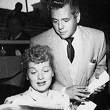And soon we had to make an important decision – one that would effect the direction and marketability of our project: one camera or three.
A little background for those not in the biz: half-hour television comedies come in two flavors, single-camera and three-camera.
Single-camera shows are taped using – wait, let me do the math—right, one camera. They are shot like films, shooting from one angle, resetting the camera, and shooting the same scene from another angle.
These shows are not shot in front of an audience, and have more flexibility with locations, outdoor scenes, and quicker, shorter scenes. Examples are Scrubs and The Office.
Three-camera shows are taped using – wait, let me do the math – right, four cameras. Okay, math doesn’t work here, but I’ll explain that later.
This was a technique developed by Desi Arnez for the I Love Lucy shows. Desi, a brilliant man, realized that the constant stopping and resetting of cameras interrupted the flow of his talented wife, and made it harder to recapture the energy that made her so popular in their live shows.
Three cameras shooting different angles at the same time and a live audience solved that problem, and helped to make Lucille Ball the superstar of television. It also set the standard for sit-coms (situation comedies), which until recently were predominately three-camera shows (examples include Everybody Loves Raymond and Friends).
(Side note: the studios did not want Desi to play Lucy’s husband, figuring that the American public would not accept a mixed marriage on television. The couple toured a version of their show, selling out across the nation and proving the suits wrong – and thus earning Desi his place in front of the camera.)
Oh, about the fourth camera: you can thank Robin Williams for that. Seriously, thank him – he is responsible for  supporting the careers of one fourth of the cameramen in television.
supporting the careers of one fourth of the cameramen in television.
You see, when Mork and Mindy was airing, the manic Williams kept popping out of frame, so the producers put in a fourth camera to do nothing but follow him around. The idea caught on, and it became standard for three-camera sit-coms to have a fourth, floating camera.
Perhaps to easiest way to describe the difference between the two types of shows is in the feel. Single-camera shows feel more like watching film; three-camera shows feel more like watching live theatre.
The more we developed our show (tentatively called Hollywood Heartland at the time), the more it started to feel like a three-camera show. But these days, single-camera shows are all the rage, and there is a sentiment out there that triples were unfunny, too old-fashioned, and past their prime.
So, armed with that information, we made the only sensible choice.
We decided to make it a three-camera sit-com.
Next: Two More Decisions Guaranteeing the Demise of our Show
Just my thoughts,
Sean
1 comment:
So...
Old friend. Help me out. I've got a great idea for a show and want to begin writing it as a collaboration with a friend. He's enthusiastic but wants some assurances it might get considered by someone who could actually do something with it.
Neither of us is in L.A.
Am I living in a fantasy world? I don't mind being a long shot, but a little wisdom in this matter goes a long way.
Should we need to pitch first or write first?
Dan
PS - looking forward to the symposium!
Post a Comment